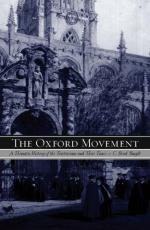The year 1841, though it had begun in storm, and though signs were not wanting of further disturbance, was at Oxford, outwardly at least, a peaceable one. A great change had happened; but, when the first burst of excitement was over, men settled down to their usual work, their lectures, or their reading, or their parishes, and by Easter things seemed to go on as before. The ordinary habits of University life resumed their course with a curious quietness. There was, no doubt, much trouble brooding underneath. Mr. Ward and others continued a war of pamphlets; and in June Mr. Ward was dismissed from his Mathematical Lectureship at Balliol. But faith in the great leader was still strong. No. 90, if it had shocked or disquieted some, had elicited equally remarkable expressions of confidence and sympathy from others who might have been, at least, silent. The events of the spring had made men conscious of what their leader was, and called forth warm and enthusiastic affection. It was not in vain that, whatever might be thought of the wisdom or the reasonings of No. 90, he had shown the height of his character and the purity and greatness of his religious purpose; and that being what he was, in the eyes of all Oxford, he had been treated with contumely, and had borne it with patience and loyal submission. There were keen observers, to whom that patience told of future dangers; they would have liked him to show more fight. But he gave no signs of defeat, nor, outwardly, of disquiet; he forbore to retaliate at Oxford: and the sermons at St. Mary’s continued, penetrating and searching as ever, perhaps with something more pathetic and anxious in their undertone than before.
But if he forbore at Oxford, he did not let things pass outside. Sir Robert Peel, in opening a reading-room at Tamworth, had spoken loosely, in the conventional and pompous way then fashionable, of the all-sufficing and exclusive blessings of knowledge. While Mr. Newman was correcting the proofs of No. 90, he was also writing to the Times the famous letters of Catholicus; a warning to eminent public men of the danger of declaiming on popular commonplaces without due examination of their worth. But all seemed quiet. “In the summer of 1841,” we read in the Apologia, “I found myself at Littlemore without any harass or anxiety on my mind. I had determined to put aside all controversy, and set myself down to my translation of St. Athanasius.” Outside of Oxford there was a gathering of friends in the summer at the consecration of one of Mr. Keble’s district churches, Ampfield—an occasion less common and more noticeable then than now. Again, what was a new thought then, a little band of young Oxford men, ten or twelve, taxed themselves to build a new church, which was ultimately placed at Bussage, in Mr. Thomas Keble’s parish. One of Mr. Keble’s curates, Mr. Peter Young, had been refused Priest’s orders by the Bishop of Winchester, for alleged unsoundness on the doctrine




